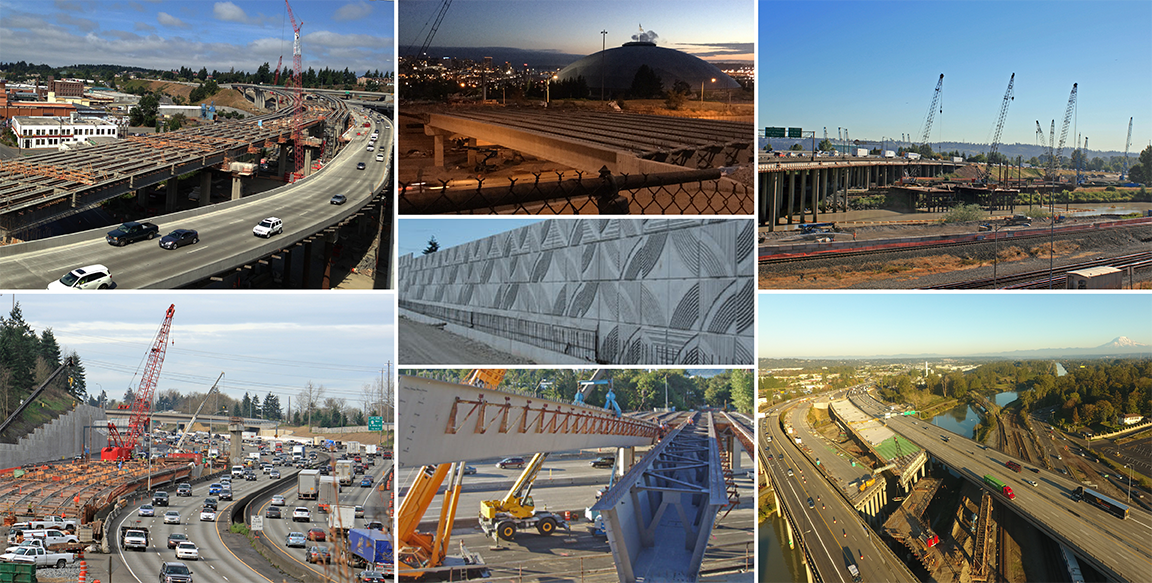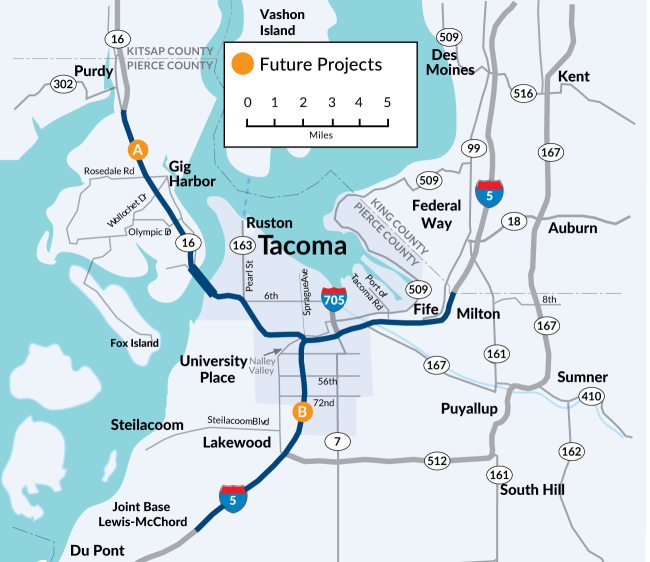In addition new HOV lanes, these projects made the following improvements:
- Safety – Additional merge lanes, wider shoulders, improved ramp alignments and curves and improved lighting.
- Traffic and Operations – Improved mobility due to additional capacity, better roadway alignments and the relocation of on-ramps and exits.
- Environment – Noise barriers at select locations to minimize traffic noise, enhance or expand nearby wetlands and improved methods to treat storm water runoff.
- Intelligent Transportation System (ITS) – New closed-circuit traffic cameras, more electronic signs for traveler notifications, highway advisory radio broadcast transmitters and traffic data collectors. Each of these tools helps WSDOT better manage traffic and improve communication with the traveling public.
HOV stands for High Occupancy Vehicle, and is a designation WSDOT gives to highway lanes restricted to vehicles carrying two persons or more. In the early 1990s, WSDOT began in earnest to build a core HOV system on state highways around greater Seattle, and has been expanding the system ever since.
WSDOT's core HOV system plan includes designing and constructing about 320 lane miles of HOV lanes. Currently, WSDOT has built and opened about 235 of those HOV lane miles, most of which are located north of the King/Pierce County line. They can be found on numerous highways and interstates, including Interstate 5, Interstate 405, Interstate 90, State Route 520, State Route 509, State Route 525, State Route 526, State Route 167, State Route 522 and State Route 99.
WSDOT believes we cannot build our way out of congestion. However, we can make the best possible use of new and existing highway capacity. To that end, WSDOT has established policies regarding the HOV system. The goals of the system are:
- To maximize the people-carrying capacity of the freeway system by providing incentives to use buses, vanpools and carpools.
- To provide capacity for future travel growth.
- To help reduce transportation-related pollution and dependency on fossil fuels.
Through HOV programs and policies, we strive to make the best use of existing facilities by increasing freeway efficiency and promoting programs to move more people in fewer vehicles.
Public involvement activities started as early as July 1993 when the program was initially envisioned. Since then, public presentations, open houses and hearings have been held to provide opportunities for public input.
Community Partners
- City of Tacoma
- Puyallup Tribe of Indians
- City of Fife
- Port of Tacoma
- Pierce Transit
- Sound Transit
- Tacoma Chamber of Commerce
- Washington State Patrol
Tacoma/Pierce County HOV Program project series
The Tacoma/Pierce County HOV Program consists of a series of a projects that started in 2001 and reached substantial completion in 2023.
Completed projects
2023 - I-5: Portland Avenue to Port of Tacoma Road - Southbound HOV
Construction began on the I-5: Portland Avenue to Port of Tacoma Road - Southbound HOV project in February 2019. This project realigned and built a new southbound I-5 bridge over the Puyallup River and removed the 1960s era northbound and southbound Puyallup River Bridges. The project also built a new I-5/East L Street overpass, widened northbound and southbound I-5 for HOV lanes, rehabilitated mainline I-5 pavement, upgraded signing and illumination, and built new stormwater collection and treatment facilities.
2023 - SR 167 - SR 410 to SR 18 NB Congestion Management
Work began in May 2021 on the SR 167 - SR 410 to SR 18 NB Congestion Management project. The contractor built a new northbound HOV lane on SR 167. The new HOV lane begins near State Route 410 in Pierce County, and continues north, tying into the existing SR 167 HOT Lane near Auburn in King County.
2019 - I-5 - SR 16 Realignment - HOV Structures and Connections
This project widened I-5 at the SR 16 interchange for direct connect HOV lanes between the two highways. In 2017, crews began building a new HOV viaduct bridge structure for eastbound and westbound SR 16 travelers. The project replaced aging pavement on I-5, upgraded signing, ITS, illumination and stormwater collection facilities. This was the final project that rebuilt the Nalley Valley Viaduct.
2018 - I-5: M Street to Portland Avenue - HOV
This project began in 2014 and built three new bridges and widened both directions of I-5. It was considered one of the more challenging projects because of the small work space available for staging construction equipment. In this contract, crews reconstructed the I-5/Pacific Avenue and I-5/McKinley Way overpasses and built a new I-5 bridge over SR 7 and I-705. The project upgraded signing, illumination, and stormwater collection facilities, and replaced the original roadway surface of I-5 as it had reached the end of its life.
2018 - I-5: Portland Avenue to Port of Tacoma Road - Northbound HOV
This project started in 2015, and finished in 2018. Crews realigned and built a new northbound I-5 bridge over the Puyallup River, and a new exit and ramp to SR 167. This project widened a section of I-5 for future HOV lanes, replaced aging roadway surface on I-5 and made improvements to the I-5/Portland Avenue interchange.
2014 - I-5/SR 16: Eastbound Nalley Valley
The eastbound Nalley Valley construction contract built a new eastbound connection between SR 16 and Interstate 5. The new eastbound viaduct and associated ramps opened to traffic in August 2014. This was the second of three projects that rebuilt the Nalley Valley Viaduct.
2012 - I-5: Portland Avenue to Port of Tacoma Road - Northbound HOV Stage 1
In this first contract, crews focused on widening, seismic upgrades and ground improvements to prepare for future projects that will ultimately help improve traffic flow on I-5 through Tacoma.
2011 - I-5/SR 16: Westbound Nalley Valley
The westbound Nalley Valley construction contract built a new westbound connection between SR 16 and Interstate 5. The project also built three new ramps at the SR 16/ Sprague Avenue interchange: 1) southbound I-5 to Sprague Ave., 2) northbound I-5 to Sprague Ave., and 3) Sprague Ave. to westbound SR 16.This was the first of three projects that rebuilt the Nalley Valley Viaduct.
2010 - I-5: Port of Tacoma Road to King County Line
Crews opened almost 6 HOV lane miles on I-5 (3 northbound and 3 southbound) from the King County Line to the Port of Tacoma Road.
2007 - Tacoma Narrows Bridge
Although the new Tacoma Narrows Bridge is not funded with monies in the HOV Program (it is funded through tolls instead), HOV projects sandwich the bridge, making it a vital transportation link for HOV projects in Pierce County. All construction included in the bridge project is now complete. The bridge opened to traffic on July 15, 2007.
2008 - I-5 - HOV Improvements - South 48th Street to Pacific Avenue
This project prepared for the reconstruction of the Nalley Valley Viaduct. It also built a new collector/distributor lane, wider shoulders and reconstructed the Yakima/Thompson and G Street/Delin bridges over I-5. The project also relocated the I-5 exit to downtown Tacoma.
2007 - SR 16 - HOV Improvements - Olympic Drive to Union Avenue
This project built ten miles of HOV lanes and were Pierce County's first HOV lanes.
2006 - SR 16 - 36th Street Interchange to Olympic Drive
This project added HOV lanes between Olympic Drive and 36th Street, widened the median and installed concrete barrier. This project also lengthened the Olympic Drive on-ramp to SR 16.
2004 - SR 16 - Pearl Street to Jackson Avenue
Widened and made improvements to SR 16 for future HOV lanes.
2002 - SR 16 - Sprague Avenue Interchange to Snake Lake Project
This project widened SR 16 for future HOV lanes, widened the Cedar Street and Union Avenue bridges, made improvements to Union Avenue ramps and prepared for improvements to the Nalley Valley interchange.
2001 - I-5/SR 16 Interchange: Rebuild Interchange - 38th Street
This contract built a new pedestrian bridge, modified ramps, rebuilt the interchange and widened I-5 for future HOV lanes.
Future projects included in the HOV Program
WSDOT's Puget Sound Freeway HOV System includes two projects within the Tacoma/Pierce County HOV Program. They are identified on the map using yellow dots.
SR 16 - Olympic Drive Interchange to Purdy - HOV Lanes would extend HOV lanes north from Olympic Drive interchange to Purdy, and widen SR 16 to provide HOV lanes. This project is unfunded for design or construction.
I-5/S. 38th Street to Thorne Lane - HOV Lanes adds HOV lanes in both directions on I-5 from South 38th Street to the JBLM HOV lanes. This project has funding included in the Move Ahead Washington Transportation Package. Delivery schedule has not been identified.
Videos
I-5 and SR 16 Tacoma/Pierce County HOV Program
Flickr Photo Albums
I-5 Portland Avenue to Port of Tacoma Road - Southbound HOV Project
I-5 Portland Avenue to Port of Tacoma Road - Northbound HOV Project
I-5 M Street to Portland Avenue - HOV Project
I-5 / SR 16 Realignment - HOV Structures and Connections Project
I-5 / SR 16 Eastbound Nalley Valley Project
I-5 / SR 16 Westbound Nalley Valley Project
I-5 Port of Tacoma Road to King County Line Project
SR 167 - SR 410 to SR 18 NB Congestion Management Project
Determination of Non-Significance
In April 2010, The Washington State Department of Transportation issued a Determination of Non-Significance (PDF 22 KB) for the following three projects within the Tacoma/Pierce County HOV Program:
- I-5: M Street to Portland Avenue – HOV
- I-5: Portland Avenue to Port of Tacoma Road – Northbound HOV
- I-5: Portland Avenue to Port of Tacoma Road – Southbound HOV
Each of these projects will improve traffic flow, increase traffic safety by designing and constructing southbound and northbound HOV lanes on I-5, improving ramp alignments and adding auxiliary lanes.


